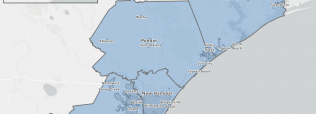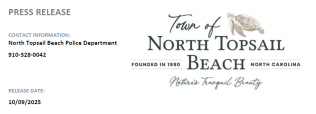Chronology: 2002 to Present
Town of North Topsail Beach
Shoreline Protection in North Topsail Beach
A Chronology: 2002 to Present
Background. Hurricanes, namely Hazel (1954), Bertha (1996), Fran (1996), Bonnie (1998), Floyd (1999), Matthew (2016), Florence (2018) and Dorian (2019) have caused major damage to Topsail Island communities over the past almost 70 years. Recovery was slow, expensive, socially demoralizing, and continues today from the effects of Florence and Dorian. Although most structures and utilities have been repaired, the Town continues with Federal Emergency Management Agency (FEMA)-supported efforts to restore dunes and the beach in North Topsail Beach.
But hurricanes aside, normal inlet and beach erosion is a natural process that occurs at various rates along the NTB shoreline due to wind and currents that combine for a natural north to south net transport of sand along the Topsail Island shoreline. For most of the NTB shoreline this historic erosion rate is 2 ft per year, although in the New River Inlet Hazard Area erosion rates can sometimes be 10 ft per year or more. While we cannot do much locally to stop the occurrence of hurricanes, we can develop a sustainable shoreline protection plan to keep up with the natural erosion, and thus protect property and infrastructure.
Shoreline Protection Begins. As a backdrop for shoreline protection in N. Topsail Beach, the Town has collaborated with our neighboring towns on Topsail Island as well as the two counties through the Topsail Island Shoreline Protection Commission (TISPC). The mission of the commission is “To actively support and promote plans and programs to restore and maintain wide sandy beaches and storm protection dunes through beach nourishment for all of Topsail Island’s oceanfront, and to support and promote development and execution of the NC Beach and Inlet Management Plan.”
In 2002, the Town of North Topsail Beach's Shoreline Protection efforts began significantly with a Request for Qualifications (RFQ) from an engineering firm. The RFQ requested a feasibility study to “protect the 11.1-mile ocean shoreline from storm and long-term erosion, and an inlet management plan for the New River Inlet that would eliminate the inlet-related erosion problems.” The RFQ requested options, to include an environmental study for the selected option. The Environmental Impact Statement (EIS) was completed in 2009 by the Town’s then coastal engineering firm and the Town’s Shoreline Protection Permit was issued.
Inlet Management Plan and Beach/Dune Nourishment. The results of the EIS along with the permit became the Town’s official “Plan of Record” and as such is the Town’s 30-yr Beach Management Plan. One recommendation in the plan by the coastal engineering firm was to divide the 11.1 miles of shoreline into five phases with Phase 1 beginning at the New River Inlet at the north end of Town and running south to Phase 2 beginning at 1768 New River Inlet Rd. (south boundary of Shipwatch Villas); Phase 3 beginning at 768 New River Inlet Rd. (south boundary of the Villa Capriani; Phase 4 beginning near the first entrance to the Town Parking Lot on New River Inlet River Rd. about 400 ft from the intersection of New River Inlet Rd. and Island Dr. (Hwy 210), and Phase 5 beginning at about 3828 Island Dr. and running south to the Surf City line.
The Major Components of the Plan were:
- The Town would dredge a realigned inlet channel perpendicular to NTB northern ocean shoreline to shift the ebbtide delta which would offer wave sheltering protection and sand accretion for the north-end inlet hazard area thus slowing the erosion rate in that area.
- The dredged sand from the inlet ocean bar (600,000 CY (cubic yards)) would be piped down the length of the beach (11.1 miles) in five consecutive annual phases, beginning with Phase 1.
- Offshore sand would supplement inlet ocean bar sand for Phases 2-5 when needed.
- The initial beach nourishment would be completed, provided funds were sufficient, in 5 years, with maintenance scheduled every 4 years from inlet-channel maintenance dredging plus offshore sand.
The major goals of the Plan were:
- Coastal protection of the Town tax base and infrastructure,
- Protect tourist/vacation economy,
- Mitigate the impact of accelerated inlet erosion, threatening adjacent property.
Since the plan was implemented, Phase 1 and 5 of the plan have been completed.
- In 2013, Phase 1 sand deposition (600,000 CY) from the inlet ocean bar was completed to realign the inlet channel at a cost of $5,600,000 using a bank loan that was amortized in 2017. A state navigation-related dredging grant was since been passed in 2013/2014 that makes future inlet projects eligible for 66.7% of total costs.
- In 2015, Phase 5 was completed (1,300,000 CY) from ocean dredging at a cost of $16,800,000 made possible by a 30-year USDA Rural Development Loan (3.25% interest with an 11-year, pre-payment agreement with the Local Government Commission (LGC)). Almost 1,800 linear feet at the north end of Phase 5 remain to be completed, but 18,520 linear feet of the total were constructed. This work resulted in the area becoming a FEMA Category G area (engineered beach) which greatly improved future FEMA funding—see description of Phase 5 2021/2022 FEMA project discussed below. Per the Towns Engineer “All FEMA engineered beach mitigation (over 805,786 cy and $26.5 million) since Phase 5 was established has realized significant funds and storm buffer protection”.
Beach Nourishment since 2015
Coastal Storm Risk Management Project: 2010-2021
(aka the Surf City – North Topsail Beach Federal Project)
The Coastal Storm Risk Management Project (“Project” and previously known as the ‘Coastal Storm Damage Reduction Project’ (CSDR)) was scoped out over a period of years and given final internal Army Corps of Engineers (Corps) approval in 2010. However, since that time the Corps had not requested ‘new start construction’ funding in their annual budget cycle request to Congress which effectively put the project on hold. It was not until Congress appropriated $751 billion to the Corps following Hurricane Florence in 2018 that our Project was selected as a ‘new start construction.’ Unfortunately, the 2012 estimated initial construction cost of $123 million had increased to $237 million by 2021 a 193% increase (plus the associated 50-year renourishment cost had increased from $245.4 million to $672.1 million, a 274% increase) with NTB’s share at $14.4 million borrowed from the Corps plus an additional $19.1 million for shore reaches that were ineligible for both Federal and State cost sharing (see below). Thus, the total cost to NTB would have been $33.7 million for just the ‘new start construction’ phase of the 50-yr project. Under the terms of the Project, the Town would also commit to a renourishment every six years.
Why the cost change in 2021? Approximately 20% of the NTB Project was deemed “ineligible” under Corps guidelines (Surf City also had areas excluded) meaning that neither the Corps nor the State would contribute at all, leaving NTB to pay 100%--the $19.1 million discussed above-of that cost. After extensive discussion among the Board of Aldermen, including recognizing that the Project is located over the same area that will receive 636,000 cubic yards of sand during 2022-2023 in the upcoming FEMA project, and based on analysis and advice from a financial consultant with extensive experience in municipal government loan borrowing and approvals, the Board voted to decline signing the USACE Project Partnership Agreement (PPA) in June 2021. While the Board was advised that it was highly unlikely that Local Government Counsel approval could be obtained, Town approval would have committed NTB to the Project and required a huge property tax increase -triple its current rate and near the State-mandated limit for municipality tax rates in North Carolina.
Associated Links:
Need for North-End Sandbag Revetment: 2015
The 2013 dredge project to realign the inlet channel to offer wave sheltering protection and sand accretion for the north-end inlet hazard area thus slowing the erosion rate in that area did not meet the intended outcome. Instead, the erosion rate increased resulting in the need to construct a sandbag revetment in 2015 to prevent loss of infrastructure at the extreme north end of New River Inlet Rd and the Beach Club development. Oceanfront homeowners were assessed to help defray cost of the $2.5 million dollar revetment, although a group of homeowners refused to pay their assessments and instead sued the Town over construction design of the revetment. The lawsuit was settled out of court with the plaintiffs’ contributing funds for the restoration of the revetment in satisfaction of the above -described assessment.
In 2017, a Revetment Committee was formed following the settlement that consisted of four members representing the members of the plaintiffs’ group and four members comprising Town staff, Town board and a citizen. The committee has met several times over the past 4 years, but issues with restoration design and contract terms with the project engineer (which is separate and independent of the Town’s current coastal engineer) have delayed restoration work substantially. Note: Even though there has been movement of some of the placed bags, the revetment has protected infrastructure behind it through Hurricane Florence, Hurricane Dorian, and numerous King Tides and Nor'easters.
NC Cedar Bush Cut project. In 2016, the Town successfully applied for a grant from the NC Shallow Draft Inlet Fund. A pipeline dredge project worked Cedar Bush Cut in the inlet to the authorized depth of 6 ft to remove shoals and place about 130,000 CY of sand on the Phase 1 beach nearest the inlet. Total cost was $2,450,000 million dollars with $1,633,317 from the state (66.7%) and a cost-share match of $408,833 each from Onslow County (16.6%) and N. Topsail Beach (16.6%). The sand from this project was placed in front of the sandbag revetment to offer additional protection to homes and infrastructure under the protection of the revetment.
Hurricane Matthew in 2016 eroded a significant portion of the dune line in Phase 5. With the assistance of FEMA, 168,000 CY of truck-hauled sand was placed in the dune line over the winter of 2019/2020.
On December 20, 2017 the Board of Aldermen received a Presentation and Report from the Town Manager summarizing the Town's plan, the completed projects, and the lessons learned. Based on the factual history since the original plan's inception and new information on funding sources and potential partners, the Town Manager recommended that the Town re-write the original plan and include a realistic construction plan for the remaining Phases 2-4.
In March of 2018, the New River Inlet Management Plan was introduced to the NTB Board of Aldermen and the Onslow County Board of Commissioners in a joint meeting led by representatives from Dial-Cordy, Inc. and Applied Technology & Management (ATM). During the presentation several alternatives were described by the ATM engineers to slow the erosion rate in the inlet area with the preferred alternative being a terminal groin; a structure which had recently been allowed in North Carolina by the State Legislature as an innovative approach to erosion mitigation in inlet areas. Participation by the Onslow County Commissioners was intended as the beginning of a partnership between Town and county as both entities would benefit from implementation of the plan. However, the county commissioners subsequently decided that the plan would not result in a great enough benefit to county taxpayers, including commercial fishermen and recreational boaters. The Town decided to move forward independently with the plan due to the imminent danger of significant property damage once the permit for the sandbag revetment expired. Accordingly, Dial-Cordy submitted a preliminary draft environmental impact statement (EIS) to the US Army Corps of Engineers, Wilmington District for review. The Corps review process requires input for all federal, state, and public interests around the environmental effect of the various alternatives and can take several years to complete. As of January 2022, the Corps has held two interagency scoping meetings to get feedback on the Preliminary Draft Environmental Impact Statement (PDEIS). Once the feedback is summarized a Draft Environmental Impact Statement (DEIS) will be published for public comments as well as for additional state and federal agencies’ feedback. Although a 2023 timeline for completion of the Corps EIS review has been given, numerous factors can slow this process making it very difficult to know when the Final Environmental Impact Statement (FEIS) might be released. For example, the terminal groin project for the Town of Ocean Isle Beach took approximately 11 years from submission of the EIS request to the Corps before construction could begin in November 2021.
Associated Links:
- The NTB Board of Aldermen had already started discussion on the inlet erosion problem in 2014 when they released the ‘Terminal Groin Fact Sheet’ on December 3, 2014.
- USACE Public Scoping Meeting: North Topsail Beach Inlet Management Master Plan (video), March 25, 2021
- USACE Scoping Meeting: North Topsail Beach Inlet Management Master Plan (notice and presentation), March 25, 2021
- USACE Scoping Meeting: North Topsail Beach Inlet Management Master Plan (presentation), December 7, 2021
- Shoreline Protection FAQ: Terminal Groins 2021
In September of 2018 Hurricane Florence struck the island with high winds but, more importantly, with over 20 inches of rain that caused major damage to many structures in town as the wind-driven rain intruded into buildings and homes for nearly a week.
Since Florence, beach nourishment efforts have been almost solely FEMA-supported projects that have restored the dunes.
- In 2019/2020, a $1.6 million grant (non-FEMA) from the state was used to extend the Hurricane Matthew Phase 5 dune restoration project into Phase 4, resulting in the complete restoration of all dunes from the Surf City line (Phase 5) to the 4300 block of Island Dr. (Phase 4).
- In 2020/2021, a FEMA-approved placement of approx. 145,000 cubic yards of truck-hauled sand were placed in Phases 2, 3, and 4 in the dune line to restore the dune to the condition prior to the two hurricanes. This project was paused on December 9, 2021, as the FEMA volume limit was reached. Additional sources of funding are being sought to finish out this dune restoration work.
- In 2021/2022, a Hurricane Florence/Dorian FEMA Category G project for Phase 5 was approved to bring about 636,000 cubic yards of truck-hauled sand for beach restoration (not dune line). Due to the large volume of sand-over 40,000 truckloads- to be placed this beach nourishment project was divided into two phases with phase one to begin in Feb/Mar of 2022 and lasting until sea turtle nesting season starts May 1st. The second phase will be bid in 2022, and sand placed Nov/Apr 2022-2023.
- In 2022/2023, a second portion of the FEMA Hurricane Dorian approved sand (15,000 CY) will be truck hauled to build up the beach berm (not dune) in Phase 1 directly behind the Topsail Reef Condominiums. More material may potentially be placed with additional state grant funding.
Army Corps Dredge Project
In the winter of 2020/2021, the Corps dredged in conjunction with Town efforts, the ICW crossing at New River Inlet, plus the channel to Jacksonville and placed the sand on the beach oceanside of the sandbag revetment. It is important to note that the Corps managed this
project. The Town assisted with Rights of Entry, easements, and other logistical matters. However, the project was wholly funded and managed by the Corps. The project was completed in April 2021.
Future of Shoreline Protection in North Topsail Beach
At the November 2021 board meeting a motion was approved to form a ‘Beach, Inlet, and Sound Advisory Committee (BISAC)’ consisting of a property owner representing each of the five phases of shoreline in NTB, two aldermen, a representative from Onslow County, and a coastal engineer advisor.
Once appointed in early 2022, the BISAC would take on the role of advising the Board of Alderman on shoreline protection matters.
Some of the tasks the BISAC will consider
- Revision of the 30-yr Beach Management Plan required by the Division of Coastal Management (DCM)
- A financial sustainable plan will be key
- New approach to moving technical corrections for developed sections of Phases 2-4 of CBRS Map Unit L06 through the US Congress
- Evaluation of the results of the US Corps of Engineers Final EIS expected in 2026/2027 for the New River Inlet, Master Management Plan (i.e., best alternative to slow the erosion rate of shoreline adjacent to New River Inlet)
Please check our projects page periodically for current and planned beach projects.




